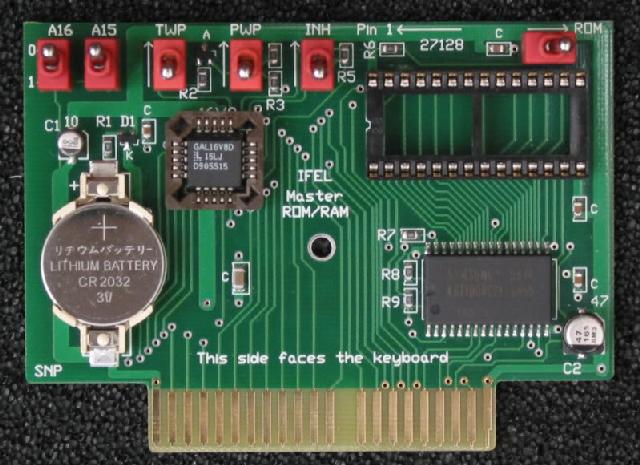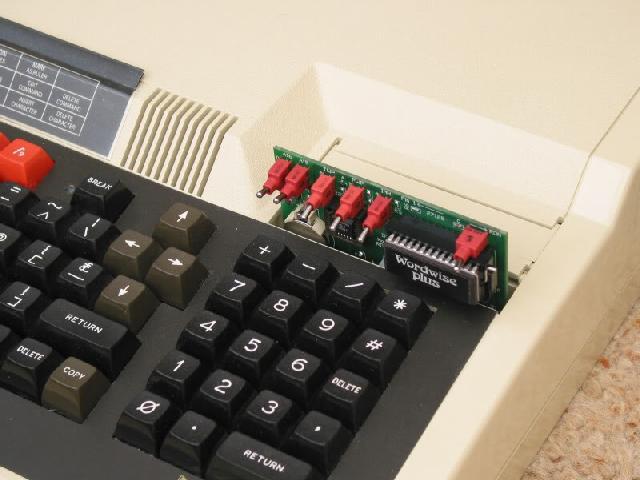
[Back ]
On ebay ctorwy31 described the BBC Master ROM RAM cartridge card as follows:
This is a board designed for use in either of the two cartridge slots provided by the Acorn BBC Master. Normally, cartridges can only hold a maximum of two ROMs but this one can store up to eight. Copies of ROM data ('ROM images') can be loaded into the eight banks of sideways RAM from the current filing system. Once loaded, the data will be retained for years by the battery backup system but obviously you can quickly overwrite it with new information at any time. Write protection is provided as standard.
The current drawn in standby mode (ie main computer turned off) is just a few microamps. Based on the quoted capacity of the CR2032 cell (about 200mAh) and the manufacturer's cell performance data, the battery will probably need changing every three years. It's a quick, easy and inexpensive process - just unclip the old battery and insert the replacement.
The 128KB RAM chip can hold up to eight 16KB ROM images, but the machine can only 'see' two at any one time. This is a limitation imposed by the Master itself because each cartridge slot was only ever designed to accept two 16KB ROMs. Effectively, with this card you have four pairs of 16KB sideways RAM. You decide which pair is active by means of the two switches at the left (marked A15 and A16). For each of the four possible positions of switches A15 and A16, the computer will be able to access just one pair of RAM banks. The other three are temporarily unavailable. To access another pair just set the switches to suit. There's no need to turn off the machine when you do this although a Ctrl-Break may be needed. Why it's needed (if at all) is explained in some depth on the accompanying CD.
If the card is inserted into the slot nearest to the keypad, the ROM images appear in ROM sockets 2 and 3. For the slot nearest the back they will appear in ROM sockets 0 and 1.
Because the tooling charges are prohibitive for small numbers. But the circuit board itself is professionally made and even the surface mount components go through our own in-house surface mount assembly line. All in all, it's a very tidy looking unit.
Ideally, you should. But remember that one of main benefits of this type of card is that you don't need to physically swap cards around in order to use a different ROM. Either flick the A15/A16 switches as required or just load the ROM image you want from the current filing system. Less swapping of cards means less wear on the edge connector.
You can fit an 8KB or 16KB ROM in the socket in the top right hand corner. To access it, you need to move the nearby switch to the right (marked 'ROM'). Of course, the computer can still only see a maximum of two ROM images on the card at any time, so you will 'lose' a bank of RAM by doing this. To get it back again (and disable the ROM socket) you just move the switch to the left.
My own Master has a ZIF socket fitted here which can be handy at times (see below). But with a huge library of ROM images available on the internet it's usually more convenient to just load the right data from the current filing system. The use of a modern solid state storage system in preference to floppies has obvious speed and convenience advantages.
They are mainly for write protection and a read inhibit facility. Both can be useful on occasions.
Can I still use the standard internal sideways RAM?
Yes. The Master provides (link selectable) 16KB of sideways RAM in sockets 4, 5, 6 and 7. The presence of this ROM/RAM card does not affect the operation of the standard RAM and the associated ROM sockets in any way. Unlike the ROM/RAM card, the internal sideways RAM cannot be readily write protected.
Yes, the rearmost slot is ROM sockets numbers 0 and 1. The other slot nearest to the numeric keypad is socket numbers 2 and 3. That is the only difference. But if you have any other kind of ROM cartridge fitted then you will probably want to fit this card in the frontmost slot and the ordinary ROM cartridge in the rearmost one (otherwise the switches are difficult to get at).
The obvious way is the Master's *SRLOAD command. However, there are some simple assembly language programs provided to do the same job. The fastest way is to *LOAD a ROM image into main memory, then write it up to the sideways ROM address space beginning at &8000. With the Turbo MMC system fitted the whole process takes about half a second, but DFS or ADFS floppies will be entirely suitable. Data may also be loaded from Compact Flash or a GoMMC unit. There is a program supplied to save ROM images to the current filing system.
BBC Master 128
Ctorwy31 sell regularly on ebay in categroy computing > vintage computing

picture © ctorwy31
BBC Master ROM RAM cartridge card

picture © ctorwy31
BBC Master ROM RAM cartridge card in Master Turbo
N/A
N/A